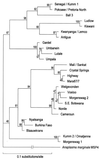Novel Ehrlichia genotype detected in dogs in South Africa
- PMID: 11682562
- PMCID: PMC88519
- DOI: 10.1128/JCM.39.11.4204-4207.2001
Novel Ehrlichia genotype detected in dogs in South Africa
Abstract
DNA samples from dogs presenting with symptoms suggestive of canine ehrlichiosis, but with no morulae detected on blood smears, frequently failed to give a positive reaction with a North American Ehrlichia canis-specific PCR assay targeting the 16S rRNA gene. We suspected the presence of a pathogen genetically different from North American E. canis, and we performed experiments to test this hypothesis. DNA from one canine blood sample was subjected to PCR with primers designed to amplify Ehrlichia (Cowdria) ruminantium ruminantium 16S and map1 genes. Amplicon sequencing yielded 16S and map1 sequences which were more closely related to other E. ruminantium sequences than to those of any other Ehrlichia species. Fifty canine DNA samples were subjected to a PCR assay, previously found to be Cowdria-specific, which targets the pCS20 gene. Thirty-seven (74%) gave a positive signal, and 16 (32%) also gave visible amplicons after gel electrophoresis, suggesting that this E. ruminantium organism is common in the Pretoria-Johannesburg area. The organism has not been isolated in culture, so we cannot definitively state that it was responsible for the canine ehrlichiosis symptoms, although the occurrence of several similar cases suggests this to be so. Most importantly, we also do not yet know whether the organism is infective for, or causes heartwater in, ruminants.
Figures


References
-
- Adachi J, Hasegawa M. MOLPHY version 2.3: programs for molecular phylogenetics based on maximum likelihood. Computer Science Monographs no. 28. Tokyo, Japan: The Institute for Statistical Mathematics; 1996.
-
- Allsopp B A, Baylis H A, Allsopp M T, Cavalier Smith T, Bishop R P, Carrington D M, Sohanpal B, Spooner P. Discrimination between six species of Theileria using oligonucleotide probes which detect small subunit ribosomal RNA sequences. Parasitology. 1993;107:157–165. - PubMed
-
- Allsopp M, Visser E S, du Plessis J L, Vogel S W, Allsopp B A. Different organisms associated with heartwater as shown by analysis of 16S ribosomal RNA gene sequences. Vet Parasitol. 1997;71:283–300. - PubMed
-
- Anderson B E, Greene C E, Jones D C, Dawson J E. Ehrlichia ewingii sp. nov., the etiologic agent of canine granulocytic ehrlichiosis. Int J Syst Bacteriol. 1992;42:299–302. - PubMed
Publication types
MeSH terms
Substances
Associated data
- Actions
- Actions
LinkOut - more resources
Full Text Sources
Other Literature Sources
Molecular Biology Databases

